![]()
![]()
![]()
Use LEFT and RIGHT arrow keys to navigate between flashcards;
Use UP and DOWN arrow keys to flip the card;
H to show hint;
A reads text to speech;
46 Cards in this Set
- Front
- Back
|
How many fissures divide the cerebellum into how many lobes?
|
Two transversely oriented fissures divide the cerebellum into three lobes.
Primary fissure: On superior surface, separates anterior and posterior lobe Posterolateral (prenodular) fissure: On inferior surface, separates posterior lobe from flocculondular lobe. |
|
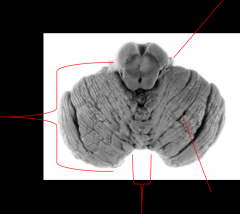
Name the parts of the cerebellum
(rostral view) |
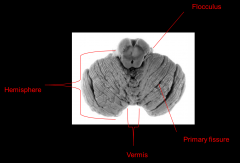
|
|

Name the parts of the cerebellum
(caudal view) |
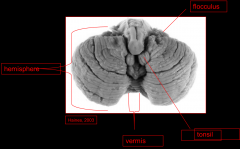
|
|
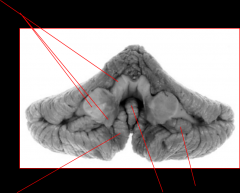
Name the parts of the cerebellum
(ventral view) |
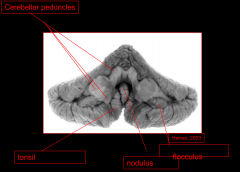
|
|
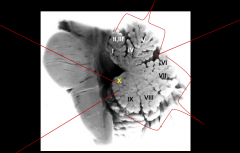
Name the parts of the cerebellum
(mid-sagittal view) |
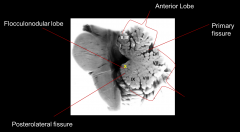
|
|
|
Lobules ______ correspond to the anterior lobe
*lobules are composed of folia (ridges) |
I-V
|
|
|
Lobules _______ correspond to the posterior lobe
|
VI-IX
|
|
|
Lobule _________ correspond to the floculonodular lobe
|
X
|
|
|
Controls eye movement (MLF) & body equilibrium (VST)
Which functional division? What is unique about this division? |
Vestibulocerebellum (flocculonodular lobe)
*STAYS w/i cerebellum |
|
|
Controls muscle tone & ongoing axial/limb movements
Which functional division? |
Spinocerebellum (vermis & paravermis)
|
|
|
Plays a role in planning & initiation of movements
Which functional division? |
Cerebrocerebellum (lateral hemisphere)
|
|
|
How many layers of cortex are there in the cerebellum?
|
3 layers:
molecular layer (outer) Purkinje cell layer (intermediate) granular cell layer (inner) |
|
|
What types of neurons are within the cerebellar cortex (5 types) ?
|
molecular layer: Basket & stellate intrinsic neurons
Purkinje cell layer: Purkinje cell principal neuron Granule cell layer: granule & golgi intrinsic neurons |
|
|
How many deep nuclei lie within the deep cerebellar gray matter?
|

|
|
|
The cerebellum receives input in a somatotopic fashion (legs ant, face post, trunk midline, extremities lateral)
from what 3 sources? |
spinal cord (spinocerebellar & cuneocerebellar tracts)
vestibular system (vestibulocerebellar tract) cerebral cortex (all cortico_______cerebellar tracts) |
|
|
What connect the cerebellum with the rest of the nervous system and how many are there?
|
Three paired white matter structures-->
-Superior cerebellar peduncle (brachium conjunctiva): efferent--> thalamus (dentatothalamic, dentatorubral) afferent<--spinal cord -Middle cerebellar peduncle (brachium pontis: afferent<--Pons (pontocerebellar tract) -Inferior cerebellar peduncle: afferent<-- olivary nuc, spinal cord, etc (olivocerebellar tract*) efferent--> reticular, vestibular |
|
|
What are the 2 main fiber systems of the cerebellum?
Which one transmits olivocerebellar input ONLY (from inferior cerebellar peduncle)? |
1. climbing fiber system
(transmits olivocerebellar input) 2. mossy fiber system (most other input) |
|
|
Describe the Climbing fiber circuit
What type of NT is involved? |
Climbing fiber--> purkinje cell & deep cerebellar nuclei
EXCITATORY- aspartate |
|
|
Describe the Mossy fiber circut
What type of NTs are involved |
Mossy fibers--> Deep cerebellar nuclei & Granule cell axons (parallel fibers)--> purkinje & intrinsic
EXCITATORY- glutamate Intrinsic neurons--> purkinje cell--> deep cerebellar nuclei INHIBITORY- GABA (*INtrinsic=INhibitory) |
|
|
Which circuit is highly focused, while the other has extensive divergence?
|
Climbing fiber (CF) input is highly focused
(Mossy fiber granule cell input has extensive divergence) |
|
|
Signal for SPATIAL RESOLUTION
|
INtrinsic stellate & basket cell axons from the plane of the parallel fiber project laterally & INhibit purkinje cells
Ex: inhibits flexors while you extend arm |
|
|
Signal for TEMPORAL RESOLUTION
|
parallel fiber excitation of Golgi Type II neurons provides feedback INHIBITION to the granule cell (& mossy fiber)
Ex: inhibits extensors to release from extension |
|
|
What is the function of the inferior olivary nucleus (ION)?
What are the 2 types of recurrent olivo-cerebellar loops? |
sends error signals related to motor commands or timing to cerebellum--> motor learning/adaptation
1. olivocerebellar mesencephalic-olivary loop 2. olivocerebellar nucleo-olivary loop |
|
|
Which loop?
projects directly to INHIBIT contralateral ION decreased synchronous discharge of ION = focuses input by inhibiting all other fibers as it excites |
Olivocerebellar nucleo-olivary loop
|
|
|
Which loop?
projects indirectly (via CTT) to ipsilateral ION increased synchronous discharge of ION = simultaneously excites both sides |
Olivocerebellar mesencephalic-olivary loop
|
|
|
Cerebellar output is via the deep nuclei. Which ones project via spinocerebellum?
which via cerebrocerebellum? |
spinocerebellum (to spinal cord):
fastigial nucleus (in medial vermis) lateral vestibular nucleus (in lateral vermis) globose & emboliform nuclei (in paravermis) cerebrocerebellum (to cerebral cortex) dentate nucleus (in lateral hemisphere) |
|
|
Globose & emboliform nuclei, located in the paravermis, project to the spinal cord via the ______________ & to the red nucleus
|
rubrospinal tract
|
|
|
Fastigal nucleus, located in the medial vermis projects the the ___________
What is the main function? |
spinal cord
involved in extraocular movement (MLF) & medial motor system (vestibulospinal & reticulospinal) |
|
|
Dentate nucleus, located in the lateral hemisphere, projects to the cerebral cortex & the __________
What is the main function? |
thalamus (VL)
Provides output to the primary motor (M1). premotor, prefrontal, & posterior parietal cortex |
|
|
What is the main function of the entire cerebellum?
|
(motor)
-error detection & correction of movement -planning & initiation of movement |
|
|
What does A HAND(3) Tremor stand for?
|
A – ataxia (uncoordinated; unsteady movement)
H – hypotonia (decreased muscle tone, passive) A – adiadochokinesia (inability to perform rapid alternating movements) N – nystagmus (jerky eye movements) D(3) – dysarthria (speech disturbance), dysmetria (difficulty measuring distance), dyssynergia (breakdown in movement, jerky ) Tremor – shaking = SIGNS of CERELLAR DISORDERS!! |
|
|
What type of tremor?
slow, course shaking during attempted voluntary movement amplitude increases towards end of movement |
intention (kinetic) tremor
|
|
|
What type of tremor?
oscilating movements of shoulders & arms when arms are outstretched occurs during maintenance of position against gravity |
static (postural) tremor
|
|
|
What type of tremor?
oscillatory movements of head or trunk rocking motion front to back, side to side, or rotatory |
Titubation
|
|
|
Describe gate ataxia (truncal ataxia)
|
wide based, clumsy, staggering gate (appear drunk)
|
|
|
Describe check & rebound in a patient w/ a cerebellar disorder
|
- removal of pressure applied to flexed forearm = unchecked flexion
- tapping of outstretched arm = oscillation of arm around intial position (rebounding) |
|
|
Describe the pendular reflex in a patient w/ a cerebellar disorder
|
tapping patellar tendon elicits reflex w/ leg swinging continuously back & forth
|
|
|
What type of cerebellar lesions would affect the trunk?
the limb? |
vermis lesions affect the trunk
hemispheric lesions affect limb |
|
|
A Unilateral cerebellar lesion will lead to (ipsilateral/contralateral) signs & symptoms
|
ipsilateral
(due to double crossed circuitry) |
|
|
What type of lesions would produce more severe signs;
deep nuclei or superior cerebellar peduncle OR cerebellar cortex? |
lesions of deep nuclei or superior cerebellar peduncle are more severe
|
|
|
which cerebellar syndrome?
disequilibrium, truncal ataxia, head tilt nystagmus, dysmetria, smooth pursuit deficits involves floculonodular lobe & vermis |
midline syndrome
|
|
|
which cerebellar syndrome?
A HAND(3) Tremor involves intermediate & lateral zones |
lateral syndrome
|
|
|
which cerebellar syndrome?
combination of midline & lateral syndrome bilateral signs involves trunk, limbs, & eyes |
pancerebellar syndrome
|
|
|
Which artery supplies?
Deep cerebellar nuclei superior cerebellar peduncle rostral middle cerebellar peduncle rostral pons |
Superior cerebellar artery
|
|
|
Which artery supplies?
flocculus caudal middle cerebellar peduncle caudal pons |
Anterior Inferior Cerebellar artert (AICA)
|
|
|
Which artery supplies?
inferior vermis tonsil & nodulus choroid plexus of 4th ventricle inferior cerebellar peduncle |
Posterior inferior cerebellar artery (PICA)
|

